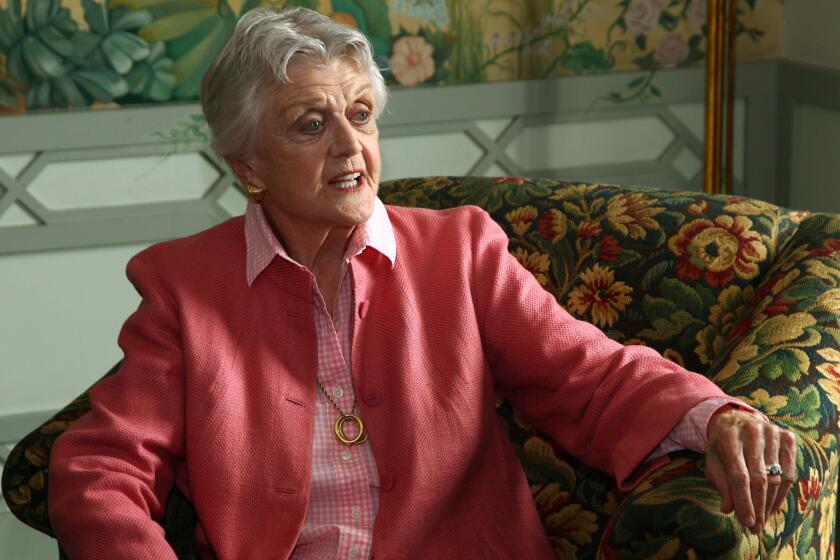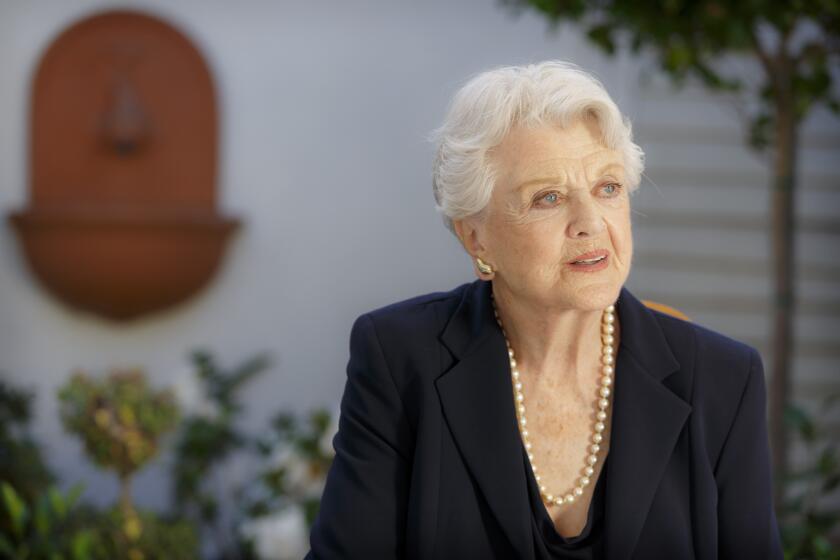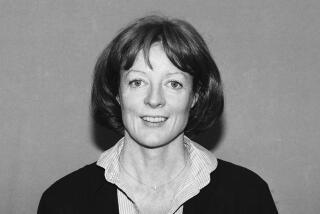Appreciation: The genius of Angela Lansbury: She could play anyone
Angela Lansbury, who achieved widespread fame as the star of the long-running CBS series âMurder, She Wroteâ and was the recipient of six Tony Awards (including an honorary one bestowed this year), was never to be confused with any other performer. A royal in exile, astringently self-possessed, her syllables arrayed like fine china, she was at once instantly recognizable and readily transformable.
Lansbury, who died on Tuesday at age 96, didnât disappear into her roles, but she could play anything. She was as much a character actor as she was a star.
In 2014, when writing a profile of Lansbury, I asked Stephen Sondheim for his thoughts on one of his most distinguished interpreters. He was away in London and missed my deadline for the piece, but I preserved his pithy remarks: âItâs hard to write about her without sounding like her agent. Suffice it to say that every playwright should have her in their play and every theater songwriter should have her in their musical.â
Angela Lansbury, a Tony Award-winning actor who captured television viewers as the star of the hit series âMurder, She Wrote,â has died. She was 96.
The daughter of an affluent English timber merchant and politician who died when she was 9, Lansbury was just a teenager when she signed a contract at Metro-Goldwyn-Mayer after having left Britain with her actor mother and brothers during World War II. She was selling cosmetics at a Los Angeles department store at the time to help support her family when studio boss Louis B. Mayer, impressed with her screen test, took a shine to her.
Hired as an attractive utility player and placed on the MGM assembly line, she was cast in supporting roles in âGaslightâ and âThe Picture of Dorian Gray,â earning Oscar nominations for her work in both films. She was Elizabeth Taylorâs older sister in âNational Velvet,â a saloon singer rival of Judy Garlandâs in âThe Harvey Girlsâ and part of a love triangle with Katharine Hepburn and Spencer Tracy in âState of the Union.â
Working alongside Hollywoodâs biggest stars was both an education and a source of frustration for Lansbury. Cast in parts that didnât always feel like an ideal fit, she saw that the studio had consigned her to the second tier. She longed for the stage, having studied drama when she arrived in the U.S. through a scholarship from the American Theatre Wing. But she had a family to support, and after she left MGM at the end of her contract, she started appearing regularly on television throughout the 1950s.
Curiously, it was after one of her most indelible film performances, playing the treacherous mother in the 1962 classic âThe Manchurian Candidate,â that she decided it was time to pursue her dream of musical theater. The prospect of being typecast by Hollywood as a maternal terror galvanized her to action. As Lansbury explained when I interviewed her at her Brentwood home in 2014, âYou canât live down a part like that. I decided, âForget it. Iâm going to sing now. Iâm going to make you happy by singing.ââ
She starred on Broadway in the Sondheim flop âAnyone Can Whistle,â which closed shortly after it opened. Playing the zany yet villainously corrupt âMayoressâ Cora Hoover Hooper, Lansbury had no interest in reprising a version of her character from âThe Manchurian Candidate.â
Angela Lansbury is officially a dame â a dame of the British Empire, that is.
She recalled a few screaming matches with book-writer and director Arthur Laurents, who became a staunch friend. To make matters worse, she hurt her voice singing the part. But this inauspicious launch of her Broadway musical career would be eclipsed by the enormous success she was to have two years later in the Jerry Herman musical âMame.â
Playing the title role of the extravagantly glamorous New York bohemian who finds herself suddenly saddled with a kid, Lansbury won the first of her Tony Awards. But something more important was gained: The respected utility player had become a bona fide Broadway star. No matter what else she did â and there would be much more â she would forever be recognized as a top-tier talent.
In a 1985 television interview with Barbara Walters, Lansbury recalled âhumblingâ herself to get the part. âItâs the one time in my career that I have done that, and I did it for âMameâ because I knew âMameâ was the key that would unlock a whole new career for me and get me out of this kind of doldrums of cameo parts that I was locked into for so many years.â
Lansbury would win her second Tony for her performance in âDear World,â a short-lived Herman musical that was a comedown from the dizzying heights of âMame.â But Broadway lightning struck again a few years later with the 1974 revival of âGypsy.â
Stepping into the notorious stage mother role that Ethel Merman originated, Lansbury knew that she couldnât compete with her predecessorâs raw theatrical power. So instead she dug into the characterâs dramatic complexities. Working again with book-writer and director Laurents, she delivered a âRoseâs Turnâ that was at once a seismic 11 oâclock number and a full-scale nervous breakdown.
Lansburyâs ability to be both broad and subtle, larger than life yet unmistakably human, was indispensable in introducing the world to âSweeney Todd: The Demon Barber of Fleet Street.â Critics were initially respectful but full of doubts about this bloody, Brechtian musical thriller by Sondheim and Hugh Wheeler. Lansbury, who by this time had become widely beloved for casting spells in the 1971 Disney film âBedknobs and Broomsticks,â brought out the comedy without undercutting the horror. She delivered the Grand Guignol with a wink that was all the more disturbing for being so eccentrically amusing.
As gracious and unpretentious as her Brentwood home, Angela Lansbury radiated hospitality as she ushered me into her living room, where her honorary Oscar sits as casually as a figurine placed on a table while a kettle was whistling.
Itâs Lansburyâs character, Mrs. Lovett, the proprietor of a seedy bakeshop, who proposes to Sweeney, the vengeful barber ready to slice throats with his razor, that something culinary could be done with all the dead bodies he plans to rack up. When the idea occurs to her that these corpses would make an ideal filling for her meat pies, she treats the matter like a perfectly reasonable business decision before giddily imagining the cannibal variety sheâll be able to offer her customers.
You can see the lightbulb go off in Lansburyâs head in the performance that was filmed for television at the Dorothy Chandler Pavilion as she launches into âA Little Priest,â the hilariously macabre number in which she and Sweeney list the pies according to the victimâs profession. Lansburyâs cockney squawks and daft, diabolical music hall flourishes delighted an audience who were willing to go wherever she was prepared to take them, even if it meant imagining âshepherdâs pie peppered with actual shepherd on top!â
Sondheimâs ingenious madness found the ideal singing character actor. A brilliant theatrical technician capable of juggling cleverness with clowning, she honored Sondheimâs wildly original lyrics with her own musical precision while making the outlandish scenario fiendishly entertaining.
Lansburyâs great gift was her ability to enter into a storybook reality, regardless of medium, and place her talents at the service of narrative. She wasnât shy of the spotlight, but then she learned from her MGM days the power of a star to sell an illusion.
When I interviewed her, she was gearing up to reprise her Tony-winning Broadway performance as the eccentric spiritualist Madame Arcati in NoĂŤl Cowardâs âBlithe Spiritâ at the Ahmanson Theatre. She was 89 and committed to working, even if it meant wearing an earpiece to stay on cue. Her honorary Oscar stood inconspicuously among the bric-a-brac. The future was her chief concern.
Lansburyâs relationship with her audience was precious to her. After 12 seasons of entering the living rooms of viewers as the mystery writer-turned-detective Jessica Fletcher on âMurder, She Wrote,â the series that began in 1984, she wanted to preserve the special connection that TV uniquely provides. Worldwide syndication of the series, to say nothing of her voice-over performance as Mrs. Potts in the 1991 Disney animated film âBeauty and the Beast,â only strengthened her desire to give back to her growing intergenerational legion of fans.
A consummate professional when acting, she was comfortable in her own skin when out of the spotlight. Proud of her British heritage, Irish roots and American home, she embraced her past, the tragedies as well as the triumphs, with the same clear-eyed aplomb with which she approached her unlimited range of characters throughout her long and exemplary career.
More to Read
The biggest entertainment stories
Get our big stories about Hollywood, film, television, music, arts, culture and more right in your inbox as soon as they publish.
You may occasionally receive promotional content from the Los Angeles Times.













